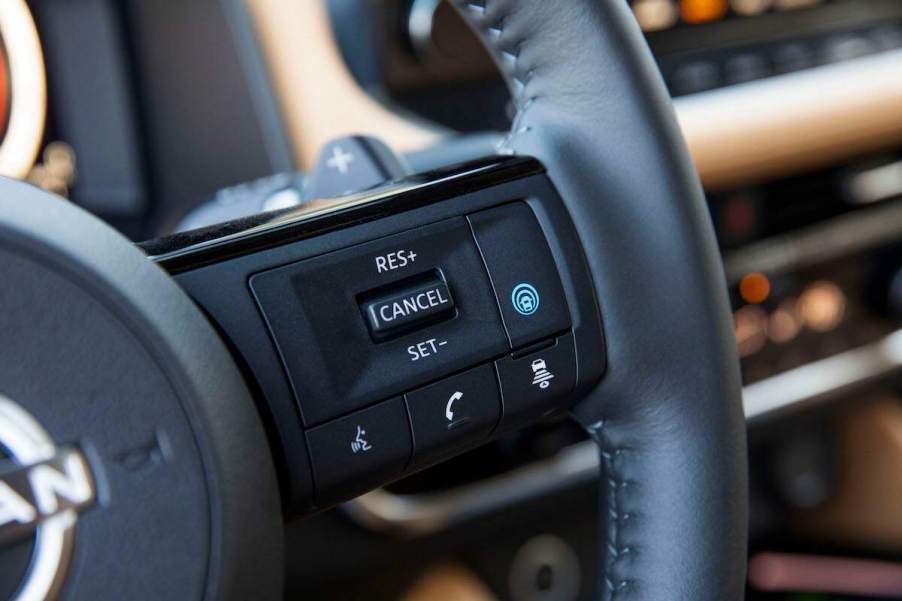
Updated: 5 Car Brands That Should Improve Their Active Driving Assistance (ADA) Systems
Most newer cars have active driving assistance (ADA) systems. These systems combine the capabilities of lane-centering assistance (LCA) and adaptive cruise control (ACC). In theory, these car safety systems create a sorf-of barrier that always keeps the vehicle at a safe distance from others.
But recent findings show that not every ADA system is created equal. Ford’s BlueCruise appears to be one of the best, along with General Motors’ Super Cruise and Mercedes-Benz’s Driver Assistance. So which systems are on the opposite end of the spectrum and have some catching up to do?
5. Rivian Highway Assist
Highway Assist lives up to its promised capabilities of safely accelerating, braking, and steering a Rivian vehicle while traveling on the highway. However, it will likely fail to keep most drivers engaged because it doesn’t include cameras to monitor driver awareness. This inevitably causes drivers to become too reliant on the system, which could lead to more accidents.
Drivers also must restart the LCA each time they turn the steering wheel while Highway Assist is active. Still, CR’s tester gave Rivian’s Highway Assist high marks for a clean presentation. It displays GPS-based geo-fencing information on the instrument cluster, allowing drivers to see their vehicle’s exact position in the lane.
4. Nissan/Infiniti ProPILOT Assist

Nissan’s ADA system is reportedly too tricky for most drivers to use because of the steering wheel controls. There are only a few buttons to configure the system, but their actions aren’t clearly labeled. The ProPILOT Assist programmed into many Nissan vehicles also doesn’t have a camera system to track driver attentiveness.
However, the automaker says it will add that feature to the Nissan Ariya via ProPILOT Assist 2.0. This updated version offers hands-off driving that can be activated on single-lane roads. With standard ProPILOT Assist, Nissan and Infiniti drivers can use it only if their hands are detected on the wheel. If not, the system will attempt to regain the driver’s attention several times before automatically deploying the brakes.
3. Honda Sensing/Acura AcuraWatch
Learning this ADA system is easy enough, and the driver will always know when it’s activated thanks to the illuminated instrument cluster. However, MotorTrend testers felt the adaptive cruise control adjusts the vehicle too roughly when trying to maintain a safe following distance.
Both Honda Sensing and AcuraWatch also got terrible scores for unresponsive driver mitigation. The system will shut off without warning if the driver doesn’t provide steering wheel feedback. It also makes no attempt to slow the car. However, CR appreciates that users can activate ACC and LCA independently.
2. Volvo/Polestar Pilot Assist
Like most ADA systems, Pilot Assist won’t tell drivers when they can safely use it. Additionally, during test drives, the system frequently switched into standby mode, where only the adaptive cruise control was operational. Test drivers felt these instances were random, detracting from the system’s ease of use. Also, no Volvo or Polestar model has a driver-facing camera monitor.
1. Hyundai/Kia/Genesis Highway Driving Assist
This version of Highway Driving Assist deactivates with no warning if it determines the driver isn’t paying attention. Also, the system reportedly couldn’t keep Kia cars inside the lane markers around curves in Consumer Reports testing. It also caused the vehicle to drift instead of settling on a consistent center-lane adjustment.
To its credit, Highway Driving Assist showcases some of the most intuitive LCA and ACC controls. It also ensures the driver uses it in the appropriate location (highways) by pulling info from the car’s navigation function. However, like any ADA system, it’s safe only when drivers devote their complete attention to the road.


